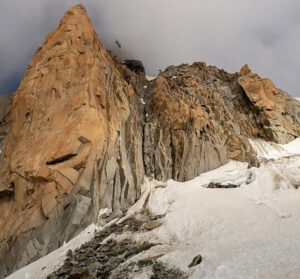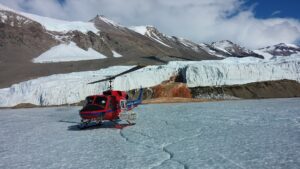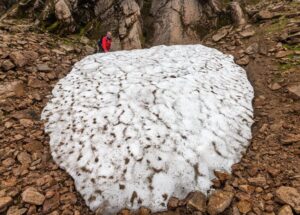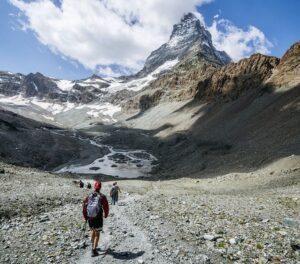An unusually dry winter followed by record-breaking summer temperatures has caused water levels to plummet in much of the world, especially in Europe. Italy’s River Tiber has dropped a metre. France’s longest river, Loire, has never flowed so slowly. The Rhine, which runs through six countries, is becoming impassable by barge.
Archaeologists and historians can be forgiven for looking at the silver lining in this summer’s worldwide drought, the worst in 500 years. As waters recede in the baking heat, ancient cities, statues, and ships have emerged from the watery tombs in which they have hidden for decades or centuries. Here are some of them.

Hunger Stones inscribed with dates of historical drought. Photo: Lithuania Post
Hunger stones
A Hunger Stone is a stark reminder of drought’s hardship. There are dozens of Hunger Stones scattered throughout Europe. These are among the continent’s oldest hydrological monuments, marking the drought years of 1417 and 1473.
Hunger Stones indicated bad harvests, lack of food, high prices, and hunger for poor people. One in Germany reads, “When this goes under, life will become colorful again.”
Spanish Stonehenge
For half a century, the so-called Spanish Stonehenge, or Guadalperal Dolmen, lay hidden in a corner of the Valdecanas Reservoir, in Spain’s Cáceres province.
Believed to be between 5,000 and 7,000 years old, the prehistoric stone circle consists of dozens of megalithic stones. German archaeologist Hugo Obermaier first discovered it in 1926. It has only been visible four times since a rural development project flooded the area in 1963.
Reservoirs dry up, ghost towns re-emerge

Aceredo. Photo: India Times
Near the Portuguese border, the small town Aceredo has similarly reappeared. In 1992, the River Lima drowned the village to make room for a reservoir. As the reservoir has dried, the ghostly buildings have returned.
When the Scar House Reservoir was created in Yorkshire in the 1920s, it covered the remains of a medieval village. Now that water in the reservoir has receded more than 50 percent, the ancient settlement has reappeared.
Even more haunting is the emergence of an abandoned Roman fort in Spain’s Ourense province. The two-hectare site of Aquis Querquennis was built between 69 and 79 AD and abandoned around 120 AD. It is usually underwater at the bottom of the As Conchas Reservoir.
Also in Spain, the gothic arches of a medieval bridge dating back to the 15th century began to peek out from the Cijara Reservoir in Extremadura in early summer. Now the bridge is fully exposed. It has been underwater for almost 70 years.
In Catalina, the small island off the north coast of the Península de Almina in Ceuta, the ancient Sant Romà de Sau church has resisted disappearing entirely by keeping a turret peering out of the water since the 1960s. Now the rest of the holy building has joined the turret on dry land.
World War II ships
In Italy, the extreme heat had been so bad that a state of emergency exists around the River Po. Recently, the river level became so low that an old German barge from World War II reappeared.
The Zibello sank in 1943 and has lain underwater until recently. Further south, the ruins of an ancient bridge from the Roman emperor Nero’s reign have resurfaced.
Europe’s second longest river, the Danube, has fallen to its lowest level in almost a century. More than 20 German warships have become visible in a Serbian section of the river near Prahovo. Some are partly buried in sandbanks. Others have bridges and turrets intact. The vessels were some of the hundreds scattered along the Danube by Nazi Germany’s Black Sea fleet in 1944.
Bodies, wreckage thaw out of glaciers

Wreckage from a 1968 plane crash on a Swiss glacier.
In Switzerland, two sets of unidentified human bones have been discovered on an old path crossing the Chessjen Glacier. No one knows how long they have been there. But as glaciers melt, the bodies of people who disappeared long ago are coming out of the ice. Currently, the police in Valais have a list of 300 people who have vanished in their region since 1925. In time, descendants of the missing 300 may learn the fate of their relatives.
The Aletsch Glacier, for example, seems to have been particularly hazardous over the years. In 2012, the bodies of three brothers who disappeared in 1926 turned up. In 2017, the remains of a couple missing since 1942 showed up on the glacier. Debris from a 1968 plane crash also turned up recently. As the Aletsch melts away, we can expect more grisly discoveries.
An Asian river reveals its treasures

These Buddhist statues are more than 600 years old. Photo: The Goa Spotlight
Further afield, three Buddhist statues more than 600 years old have emerged from China’s Yangtze River. Built during the Ming and Qing dynasties, the statues may have blessed passing boats. Today, their presence is anything but a blessing, since the drought in the region has caused a shortage of hydropower.

Dinosaur tracks. Photo: Today.com
The oldest find of all
North America may not have Roman monuments, but the hot summer has exposed something far more ancient: 113-million-year-old dinosaur tracks in central Texas. Exposed by the severe drought’s effect on a river bed, the tracks may have belonged to a single acrocanthosaurus that walked the trail for about 30m. There are an estimated 140 tracks in total from this one dinosaur, with about 60 visible now. For years, they sat beneath water and sediment. They now rank among the best preserved dinosaur tracks in the world. The acrocanthosaurus looked similar to a T. Rex and was almost as big.






